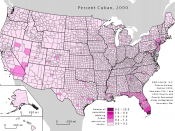Hispanic American DiversityBy: Jeremy MooreAxia CollegeCourse # ETH 125April 4th, 2008In America today the Hispanic Americans make up the largest minority group. After exploring the cultures of Mexican Americans, Puerto Ricans, Cubans, and immigrants from the central and southern Latin American regions, I have found that they may have similar immigration experiences, but their cultures can differ greatly.
The immigrants from the central and southern Latin American regions are from an assorted population, which has not been strongly studied. When it comes to differentiating these immigrants they are mainly look at as the ÃÂotherÃÂ category. They are very rarely split up by particular nationalities. One difference is that not all the immigrants from this region even have Spanish blood in them. This also means that many of them do not even speak Spanish. ÃÂAccording to Ann Orlov and Reed UedaÃÂs (1980:212) conclusion that ÃÂsocial relations among Central and South American ethnic groups in the United States defy generalization.ÃÂ
Not only do central and southern Americans not believe in conforming, they also do not associate themselves with other Hispanic groups. Many of the immigrants into the United States from this region are considered illegal immigrants. Many of the ones discovered turn out to be undocumented workers as well. In turn, many of the skilled citizens of this region have left to make better lives for themselves. This leaves the rest of the countries in dire need for professionals such as doctors, scientists, and so on. Even though many of the Central and South Americans have higher levels of education them most other Hispanics, their unemployment rates are high when compared to white Americans. Most of these immigrants end up taking menial jobs and have to combine the incomes of several different family members in order to make ends meet. Some...


